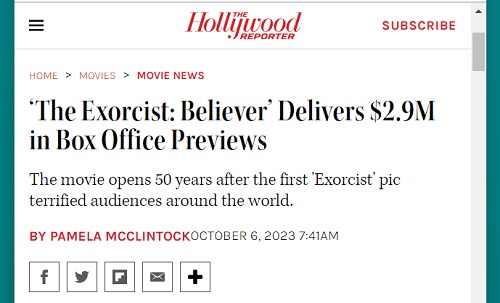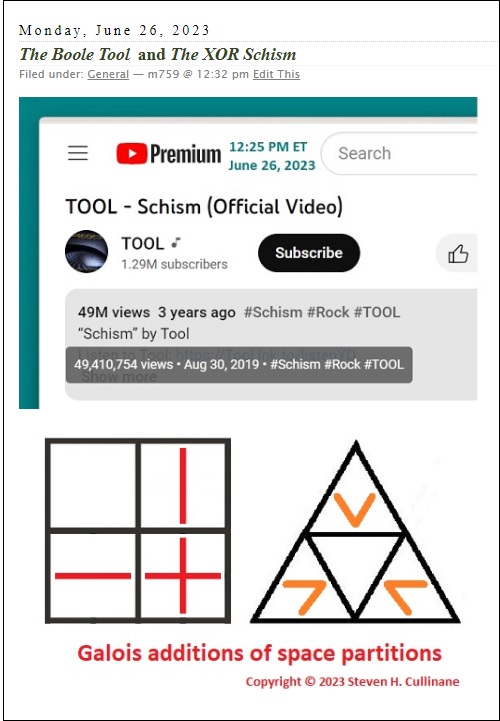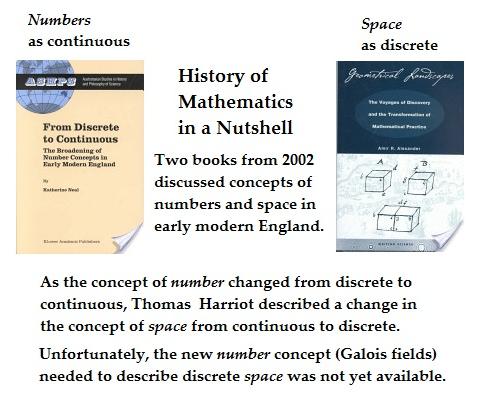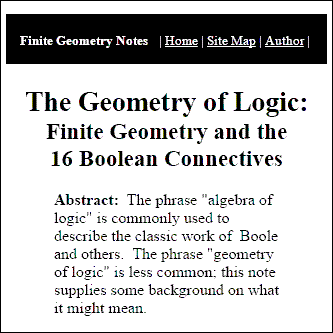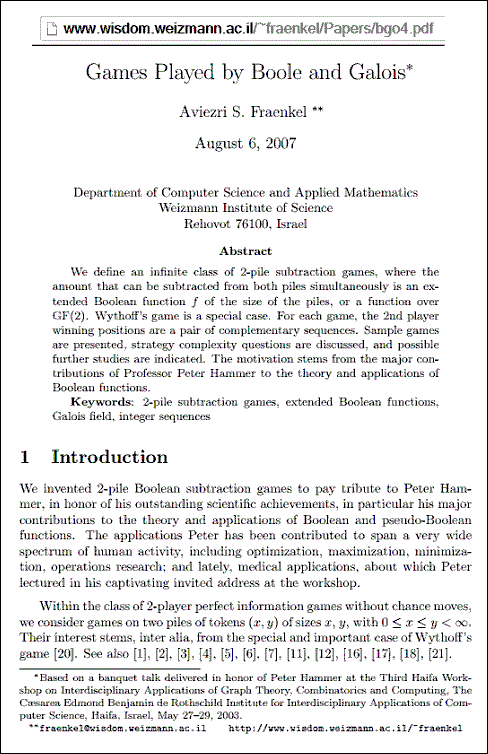Monday, June 26, 2023
The Boole Tool and The XOR Schism
Monday, May 15, 2023
Boolean Functions Review
The previous post included an illustration by Solomon Golomb
from his 1959 paper "On the Classification of Boolean Functions."
This suggests a review of some later work in this area —
This post was suggested by the word "Boolean" in a May 10
ChatGPT response —

In the above, "Boolean algebras" should be "Boolean functions,"
as indicated by Harrison's 1964 remarks.
Saturday, October 29, 2022
Boolean Halloween
From Log24 posts tagged Boole vs. Galois —
Kauffman‘s fixation on the work of Spencer-Brown is perhaps in part
due to Kauffman’s familiarity with Boolean algebra and his ignorance of
Galois geometry. See other posts now tagged Boole vs. Galois.
See also “A Four-Color Epic” (April 16, 2020).
Sunday, August 14, 2016
The Boole-Galois Games
Continued from earlier posts on Boole vs. Galois.

From a Google image search today for “Galois Boole.”
Click the image to enlarge it.
Sunday, February 18, 2024
Vocabulary Note
The URLs powerset.space and powerset.group are now operative.
Related vocabulary: See Boolean Functions Review (Log24, May 15, 2023).
Tuesday, January 2, 2024
Mathematics Made Absurd: Domain and Range
"… the dominant discourse limits the range
of discussion in each domain…."
— https://americanaffairsjournal.org/2023/11/
the-stagnant-science-mainstream-economics-in-america/
See as well Boole vs. Galois and …
Wednesday, December 6, 2023
Das Wiener Meisterstück
|
Introduction In the present article, the research work of many years is summarized in an interim report concerning the connection between logic, space, time and matter. The author always had in mind two things, namely 1. The discovery/construction of an interface between matter and mind, and 2. some entry points for the topos view that concern graphs, grade rotations and contravariant involutions in geometric Boolean lattices. In this part of the MiTopos theme I follow the historic approach to mathematical physics and remain with the Clifford algebra of the Minkowski space. It turns out that this interface is a basic morphogenetic structure inherent in both matter and thought. It resides in both oriented spaces and logic, and most surprisingly is closely linked to the symmetries of elementary particle physics.
— "MiTopos: Space Logic I," |
Sunday, October 15, 2023
Efficient Packend


"Stencils" from a 1959 paper by Golomb —

These 15 figures also represent the 15 points of a finite geometry
(Cullinane diamond theorem, February 1979).
This journal on Beltane (May 1), 2016 —
Friday, October 6, 2023
Saturday, September 30, 2023
Underlying Symbolic Structures
"As McCarthy peers through the screen, or veil, of technological modernity
to reveal the underlying symbolic structures of human experience,
The Making of Incarnation weaves a set of stories one inside the other,
rings within rings, a perpetual motion machine."
— Amazon.com description of a novel published on All Souls' Day
(Dia de los Muertos), 2021.
See also the underlying symbolic structures of Boolean functions . . .
as discussed, for instance, on Sept. 23 at medium.com —
Tuesday, June 27, 2023
The Representation of Minus One…
Continued from February 6, 2014.
This flashback to 2014 was prompted by the following search history —
Related logic —
Related material — "Boolean Functions" in this journal.
Thursday, June 15, 2023
Michaelmas 2019
Transcribed from a PDF:
|
Received September 29, 2019, accepted October 15, 2019, Digital Object Identifier 10.1109/ACCESS.2019.2949310
A Method for Determining
ZIYU WANG1 , XIAO ZENG1 , JINZHAO WU2,3, AND
1Big Data Research Center, School of Computer Science
2Guangxi Key Laboratory of Hybrid Computation and
3School of Computer and Electronic Information,
Corresponding authors:
This work was supported in part by the National Natural Science Foundation
ABSTRACT
INDEX TERMS Logic synthesis, Boolean functions, |
Meanwhile . . .
Wednesday, June 14, 2023
From Mysticism to Mathematics…
Continued from October 6, 2022 —
A paper from an August 2017 Melbourne conference
on artificial intelligence —
See as well a Log24 search for Boolean functions.
A check on the date of the above paper's presentation —

From this journal on that date —
Happy 10th birthday to the hashtag.

Monday, May 22, 2023
Triangular Hyperplane Arrangement
Abstract: Boolean functions on a triangular grid.
Note: It seems that the above rearrangement of a square array
of hyperplanes to a triangular array of hyperplanes, which was
rather arbitrarily constructed to have nice symmetries, will
answer a question posed here on Dec. 15, 2015.
Wednesday, May 17, 2023
British Combinatorics 2023
"Martin told us about his work on machine learning…."
— Peter J. Cameron reports on last week's (May 10 and 11)
London Combinatorics Colloquia 2023.
Related material — Boolean Functions in this journal and in a book
from May 16, 2011 . . .

Some historical background on machine learning —
https://tripleampersand.org/kernelled-connections-perceptron-diagram/ .
Monday, May 15, 2023
Chatbot Review
|
By ChatGPT* —
What is the Cullinane diamond theorem? The Cullinane Diamond Theorem, also known as the Diamond Theorem, is a result in combinatorial mathematics proposed by Steven H. Cullinane. The theorem explores connections between finite geometries, algebraic structures, and combinatorial designs.
The theorem is primarily concerned with four related structures: 2. Vector spaces: The theorem connects finite vector spaces over finite fields to the aforementioned finite geometries. 3. Boolean functions:* The theorem establishes relationships between the finite geometries and certain Boolean functions derived from them.
4. Symmetry groups: The theorem involves symmetry groups associated with the finite geometries. * With one revision by Cullinane: "Boolean functions" replaces "Boolean algebras." See (for instance) M. A. Harrison, “On the classification of Boolean functions by the general linear and affine groups,” Journal of the Society for Industrial and Applied Mathematics 1964 12:2, 285-299. |
Death on Beltane

"Stencils" from a 1959 paper by Golomb —

These 15 figures also represent the 15 points of a finite geometry
(Cullinane diamond theorem, February 1979).
This journal on Beltane (May 1), 2016 —
Thursday, April 6, 2023
Zero Sum

Related elementary mathematics from Google image searches —

Despite the extremely elementary nature of the above tables,
the difference between the binary addition of Boole and that
of Galois seems not to be widely known.
See "The Hunt for Galois October" and "In Memory of a Mississippi Coach."
Thursday, February 16, 2023
Reaching the Stillness
See http://m759.net/wordpress/?s="Mac+Lane"+Boolean.
An image from that search —
 .
.
A related image
for T. S. Eliot:

Tuesday, December 13, 2022
In Memory of a Mississippi Coach
Wednesday, November 23, 2022
Wednesday, October 26, 2022
The Hunt for Galois October
"… Évariste was born on October 25, 1811."
— Eric Temple Bell, Men of Mathematics
Related material —
But seriously . . .
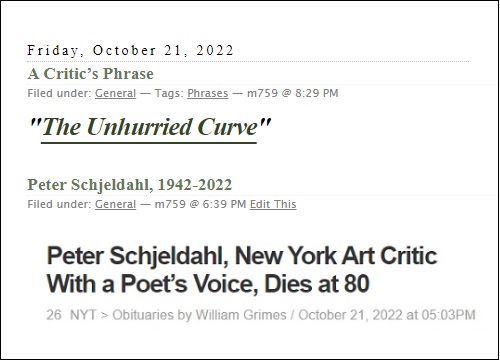
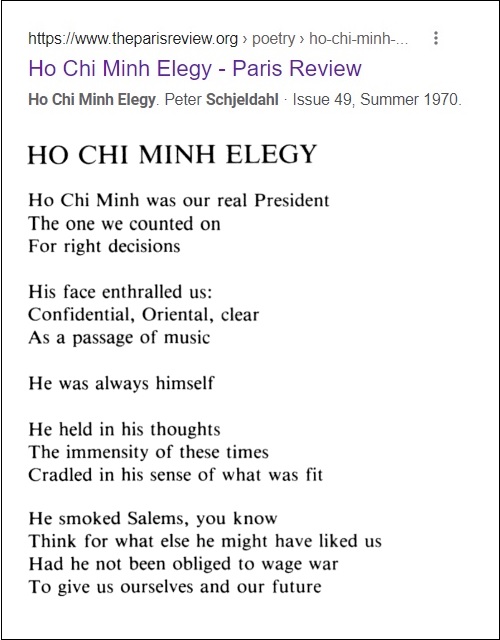
Sunday, October 9, 2022
Cutting Edge
"For Marker, memory isn’t passive; it’s an act of resistance—
the edge that cuts a path into the future—and the effective work
of memory is the very definition of art."
— July 30, 2012 in The New Yorker… Richard Brody on the late
film editor Chris Marker.
Thursday, October 6, 2022
From Mysticism to Mathematics
[Klein, 1983] S. Klein.
"Analogy and Mysticism and the Structure of Culture
(and Comments & Reply)"
Current Anthropology , 24 (2):151–180, 1983.
The citation above is from a 2017 paper —
"Analogy-preserving Functions:
A Way to Extend Boolean Samples,"
by M. Couceiro, N. Hug, H. Prade, G, Richard.
26th International Joint Conference on Artificial Intelligence
(IJCAI 2017), Aug. 2017, Melbourne, Australia. pp.1-7, ff.
That 2017 paper discusses Boolean functions .
Some more-recent remarks on these functions
as pure mathematics —
"On the Number of Affine Equivalence Classes
of Boolean Functions," by Xiang-dong Hou,
arXiv:2007.12308v2 [math.CO]. Rev. Aug. 18, 2021.
See also other posts now tagged Analogy and Mysticism.
Saturday, May 28, 2022
Grothendieck at Chapman …
Last two days of the conference, May 27 and 28, 2022 —
|
27th Friday
9:00 – 10:00 Andrés Villaveces (Univ. Nacional de Colombia):
10:00 – 11:00 Olivia Caramello (Univ. of Insubria; by Zoom): 1:00 – 11:15 Coffee Break
1:15 – 12:15 Mike Shulman (Univ. of San Diego):
12:15 – 1:15 José Gil-Ferez (Chapman Univ.) 1:15 – 2:30 Lunch
2:30 – 3:30 Oumar Wone (Chapman) :
3:30 – 4:30 Claudio Bartocci (Univ. of Genova):
4:30 – 5:30 Christian Houzel (IUFM de Paris): 28th Saturday
9:00 – 10:00 Silvio Ghilardi (Univ. degli Studi, Milano):
10:00 – 11:00 Matteo Viale (Univ. of Turin; by zoom): 11:00 – 11:15 Coffee Break
11:15 – 12:15 Benjamin Collas (RIMS, Kyoto Univ.):
12:15 – 1:15 Closing: general discussion |
Friday, April 8, 2022
Wednesday, March 30, 2022
Games
Click to enlarge.
Related reading — George Steiner's Fields of Force , on chess in Iceland, and . . .
The New Yorker , article by Sam Knight dated March 28, 2022 —
They went to Björk’s house. She cooked salmon.
She had seen “The Witch” and introduced Eggers
to Sjón, who had written a novel about seventeenth-
century witchcraft in Iceland. When he got home,
Eggers read Sjón’s books. “I was, like, this guy’s
a fucking magician,” Eggers said. “He sees all time,
in time, out of time.”
Sunday, December 6, 2020
“Binary Coordinates”
The title phrase is ambiguous and should be avoided.
It is used indiscriminately to denote any system of coordinates
written with 0 ‘s and 1 ‘s, whether these two symbols refer to
the Boolean-algebra truth values false and true , to the absence
or presence of elements in a subset , to the elements of the smallest
Galois field, GF(2) , or to the digits of a binary number .
Related material from the Web —
Some related remarks from “Geometry of the 4×4 Square:
Notes by Steven H. Cullinane” (webpage created March 18, 2004) —
A related anonymous change to Wikipedia today —
The deprecated “binary coordinates” phrase occurs in both
old and new versions of the “Square representation” section
on PG(3,2), but at least the misleading remark about Steiner
quadruple systems has been removed.
Friday, September 11, 2020
Kauffman on Algebra
Kauffman‘s fixation on the work of Spencer-Brown is perhaps in part
due to Kauffman’s familiarity with Boolean algebra and his ignorance of
Galois geometry. See other posts now tagged Boole vs. Galois.
See also “A Four-Color Epic” (April 16, 2020).
Wednesday, November 6, 2019
Soul Snatchers
From All Souls' Day 2015 —
Related entertainment —
Invasion of the Soul Snatchers (Wild Palms review, 1993).
Tuesday, August 13, 2019
Putting the Structure in Structuralism
(From his “Structure and Form: Reflections on a Work by Vladimir Propp.”
Translated from a 1960 work in French. It appeared in English as
Chapter VIII of Structural Anthropology, Volume 2 (U. of Chicago Press, 1976).
Chapter VIII was originally published in Cahiers de l’Institut de Science
Économique Appliquée , No. 9 (Series M, No. 7) (Paris: ISEA, March 1960).)

The structure of the matrix of Lévi-Strauss —
Illustration from Diamond Theory , by Steven H. Cullinane (1976).
The relevant field of mathematics is not Boolean algebra, but rather
Galois geometry.
Thursday, July 19, 2018
The Corrections (Continued)
A search for the phrase "nonlinear Boolean algebra" yields few results.
"Nonlinear Boolean functions " seems to be the phrase intended.
On the mathematics of nonlinear Boolean functions —

A memorable death —
For those who prefer narrative to mathematics —
A related image —
Sunday, April 29, 2018
Amusement
From the online New York Times this afternoon:
Disney now holds nine of the top 10
domestic openings of all time —
six of which are part of the Marvel
Cinematic Universe. “The result is
a reflection of 10 years of work:
of developing this universe, creating
stakes as big as they were, characters
that matter and stories and worlds that
people have come to love,” Dave Hollis,
Disney’s president of distribution, said
in a phone interview.
From this journal this morning:
"But she felt there must be more to this
than just the sensation of folding space
over on itself. Surely the Centaurs hadn't
spent ten years telling humanity how to
make a fancy amusement-park ride.
There had to be more—"
— Factoring Humanity , by Robert J. Sawyer,
Tom Doherty Associates, 2004 Orb edition,
page 168
"The sensation of folding space . . . ."
Or unfolding:
Click the above unfolded space for some background.
Saturday, February 17, 2018
The Binary Revolution
Michael Atiyah on the late Ron Shaw —

Phrases by Atiyah related to the importance in mathematics
of the two-element Galois field GF(2) —
- “The digital revolution based on the 2 symbols (0,1)”
- “The algebra of George Boole”
- “Binary codes”
- “Dirac’s spinors, with their up/down dichotomy”
These phrases are from the year-end review of Trinity College,
Cambridge, Trinity Annual Record 2017 .
I prefer other, purely geometric, reasons for the importance of GF(2) —
- The 2×2 square
- The 2x2x2 cube
- The 4×4 square
- The 4x4x4 cube
See Finite Geometry of the Square and Cube.
See also today’s earlier post God’s Dice and Atiyah on the theology of
(Boolean) algebra vs. (Galois) geometry:

Monday, June 12, 2017
Bubble
The "bubble" passage in the previous post suggests a review of
a post from December 21, 2006, with the following images —


Update of 11:01 PM ET the same day, June 12, 2017 —
Related material for the Church of Synchronology —
From a tech-article series that began on Halloween 2006 and
ended on the date of the above Geometry's Tombstones post —



Compare and contrast (from a post of Feb. 27, 2017) —
“Lord Arglay had a suspicion that the Stone would be
purely logical. Yes, he thought, but what, in that sense,
were the rules of its pure logic?”
—Many Dimensions (1931), by Charles Williams
See also "The Geometry of Logic:
Finite Geometry and the 16 Boolean Connectives"
by Steven H. Cullinane in 2007.
Thursday, April 20, 2017
Stone Logic
See also “Romancing the Omega” —
Related mathematics — Guitart in this journal —
See also Weyl + Palermo in this journal —
Sunday, April 16, 2017
Art Space Paradigm Shift

This post’s title is from the tags of the previous post —
The title’s “shift” is in the combined concepts of …
Space and Number
From Finite Jest (May 27, 2012):
The books pictured above are From Discrete to Continuous ,
by Katherine Neal, and Geometrical Landscapes , by Amir Alexander.
For some details of the shift, see a Log24 search for Boole vs. Galois.
From a post found in that search —
“Benedict Cumberbatch Says
a Journey From Fact to Faith
Is at the Heart of Doctor Strange“
— io9 , July 29, 2016
” ‘This man comes from a binary universe
where it’s all about logic,’ the actor told us
at San Diego Comic-Con . . . .
‘And there’s a lot of humor in the collision
between Easter [ sic ] mysticism and
Western scientific, sort of logical binary.’ “
[Typo now corrected, except in a comment.]
Sunday, January 29, 2017
Lottery Hermeneutics
For some backstory, see Lottery in this journal,
esp. a post of June 28, 2007:
Real Numbers: An Object Lesson.
One such number, 8775, is suggested by
a Heinlein short story in a Jan. 25 post.
A search today for that number —
That Jan. 25 post, "For Your Consideration," also mentions logic.
Logic appears as well within a post from the above "8775" date,
August 16, 2016 —
|
Update of 10 am on August 16, 2016 —
See also Atiyah on the theology of |
Related: Remarks by Charles Altieri on Wittgenstein in
today's previous post.
For remarks by Wittgenstein related to geometry and logic, see
(for instance) "Logical space" in "A Wittgenstein Dictionary," by
Hans-Johann Glock (Wiley-Blackwell, 1996).
Friday, November 25, 2016
Priority
Before the monograph "Diamond Theory" was distributed in 1976,
two (at least) notable figures were published that illustrate
symmetry properties of the 4×4 square:
Hudson in 1905 —
Golomb in 1967 —

It is also likely that some figures illustrating Walsh functions as
two-color square arrays were published prior to 1976.
Update of Dec. 7, 2016 —
The earlier 1950's diagrams of Veitch and Karnaugh used the
1's and 0's of Boole, not those of Galois.
Wednesday, September 21, 2016
Cork
The phrase "binary opposition" in the previous post suggests
a review of some binary-related concepts —
From a post on St. Finbarr's Day 2015 —
From http://www.chosentwo.com/buffy/quotes/harvest.php —
|
Buffy: So, Giles! Got anything that can make this day any worse?
Giles: This is what we know. Some sixty years ago, a very old, very powerful vampire came to this shore, not just to feed. |

Tuesday, August 16, 2016
Midnight Narrative
The images in the previous post do not lend themselves
to any straightforward narrative. Two portions of the
large image search are, however, suggestive —

Cross and Boolean lattice.
The improvised cross in the second pair of images
is perhaps being wielded to counteract the
Boole of the first pair of images. See the heading
of the webpage that is the source of the lattice
diagram toward which the cross is directed —
Update of 10 am on August 16, 2016 —
See also Atiyah on the theology of
(Boolean) algebra vs. (Galois) geometry:

Saturday, July 30, 2016
Binary
"Benedict Cumberbatch Says a Journey
From Fact to Faith Is at the Heart of Doctor Strange"
— io9 yesterday
" 'This man comes from a binary universe where it’s all about logic,'
the actor told us at San Diego Comic-Con . . . .
'And there’s a lot of humor in the collision between Easter [sic ]
mysticism and Western scientific, sort of logical binary.' "
Related material — Strange Awards, April 14, 2016.
I prefer a different sort of journey. See Boole vs. Galois.
Wednesday, July 20, 2016
Weather for Jews
"What I'm aiming for are moments of strong sensation —
moments of total physical experience of the landscape,
when weather just reaches out and sucks you in."
— The late Jane Wilson —
See also the previous post and, from the date of Wilson's death,
Thursday, April 14, 2016
One Funeral at a Time
On this date in 2005, mathematician Saunders Mac Lane died at 95.
Related material —
Max Planck quotations:
Mac Lane on Boolean algebra:
Mac Lane’s summary chart (note the absence of Galois geometry ):

I disagree with Mac Lane’s assertion that “the finite models of
Boolean algebra are dull.” See Boole vs. Galois in this journal.
Wednesday, January 13, 2016
Geometry for Jews
(Continued from previous episodes)
Boole and Galois also figure in the mathematics of space —
i.e. , geometry. See Boole + Galois in this journal.
Related material, according to Jung’s notion of synchronicity —
- This journal on the date, August 6, 2007, of the
above paper, and the following day —
posts now tagged Metamorphosis 2007 - This journal on two of the dates of the 2003 Haifa workshop
that the paper mentions in a footnote —
posts now tagged Solomon’s Mental Health Month
Tuesday, January 12, 2016
Lechner’s Beginning
… Professionally, at least …
Click image to enlarge.
See also the previous post, Lechner's End.
For a more up-to-date look at harmonic analysis
and switching functions (i.e., Boolean functions),
see Ryan O'Donnell, Analysis of Boolean Functions ,
Cambridge U. Press, 2014. Page 40 gives an
informative overview of the history of this field.
Monday, January 11, 2016
Space Oddity
It is an odd fact that the close relationship between some
small Galois spaces and small Boolean spaces has gone
unremarked by mathematicians.
A Google search today for “Galois spaces” + “Boolean spaces”
yielded, apart from merely terminological sources, only some
introductory material I have put on the Web myself.
Some more sophisticated searches, however led to a few
documents from the years 1971 – 1981 …
“Harmonic Analysis of Switching Functions” ,
by Robert J. Lechner, Ch. 5 in A. Mukhopadhyay, editor,
Recent Developments in Switching Theory , Academic Press, 1971.
“Galois Switching Functions and Their Applications,”
by B. Benjauthrit and I. S. Reed,
JPL Deep Space Network Progress Report 42-27 , 1975
D.K. Pradhan, “A Theory of Galois Switching Functions,”
IEEE Trans. Computers , vol. 27, no. 3, pp. 239-249, Mar. 1978
“Switching functions constructed by Galois extension fields,”
by Iwaro Takahashi, Information and Control ,
Volume 48, Issue 2, pp. 95–108, February 1981
An illustration from the Lechner paper above —

“There is such a thing as harmonic analysis of switching functions.”
— Saying adapted from a young-adult novel
Monday, December 28, 2015
ART WARS Continues
Combining two headlines from this morning’s
New York Times and Washington Post , we have…
Deceptively Simple Geometries
on a Bold Scale
Voilà —
Click image for details.
More generally, see
Boole vs. Galois.
Friday, December 25, 2015
Dark Symbol
Related material:
The previous post (Bright Symbol) and
a post from Wednesday,
December 23, 2015, that links to posts
on Boolean algebra vs. Galois geometry.
“An analogy between mathematics and religion is apposite.”
— Harvard Magazine review by Avner Ash of
Mathematics without Apologies
(Princeton University Press, January 18, 2015)

Wednesday, December 23, 2015
Splitting Apart
Monday, November 2, 2015
The Devil’s Offer
This is a sequel to the previous post and to the Oct. 24 post
Two Views of Finite Space. From the latter —
” ‘All you need to do is give me your soul:
give up geometry and you will have this
marvellous machine.’ (Nowadays you
can think of it as a computer!) “
Colorful Story
"The office of color in the color line
is a very plain and subordinate one.
It simply advertises the objects of
oppression, insult, and persecution.
It is not the maddening liquor, but
the black letters on the sign
telling the world where it may be had."
— Frederick Douglass, "The Color Line,"
The North American Review , Vol. 132,
No. 295, June 1881, page 575
Or gold letters.
From a search for Seagram in this journal —


"The colorful story of this undertaking begins with a bang."
— Martin Gardner on the death of Évariste Galois
Saturday, October 31, 2015
Raiders of the Lost Crucible
Stanford Encyclopedia of Philosophy
on the date Friday, April 5, 2013 —
“First published Tue Sep 24, 1996;
substantive revision Fri Apr 5, 2013”
This journal on the date Friday, April 5, 2013 —
The object most closely resembling a “philosophers’ stone”
that I know of is the eightfold cube .
For some related philosophical remarks that may appeal
to a general Internet audience, see (for instance) a website
by I Ching enthusiast Andreas Schöter that displays a labeled
eightfold cube in the form of a lattice diagram —

Related material by Schöter —
A 20-page PDF, “Boolean Algebra and the Yi Jing.”
(First published in The Oracle: The Journal of Yijing Studies ,
Vol 2, No 7, Summer 1998, pp. 19–34.)
I differ with Schöter’s emphasis on Boolean algebra.
The appropriate mathematics for I Ching studies is,
I maintain, not Boolean algebra but rather Galois geometry.
See last Saturday’s post Two Views of Finite Space.
Unfortunately, that post is, unlike Schöter’s work, not
suitable for a general Internet audience.
Saturday, October 24, 2015
Two Views of Finite Space
The following slides are from lectures on “Advanced Boolean Algebra” —

The small Boolean spaces above correspond exactly to some small
Galois spaces. These two names indicate approaches to the spaces
via Boolean algebra and via Galois geometry .
A reading from Atiyah that seems relevant to this sort of algebra
and this sort of geometry —

” ‘All you need to do is give me your soul: give up geometry
and you will have this marvellous machine.’ (Nowadays you
can think of it as a computer!) “
Related material — The article “Diamond Theory” in the journal
Computer Graphics and Art , Vol. 2 No. 1, February 1977. That
article, despite the word “computer” in the journal’s title, was
much less about Boolean algebra than about Galois geometry .
For later remarks on diamond theory, see finitegeometry.org/sc.
Wednesday, October 21, 2015
Algebra and Space
"Perhaps an insane conceit …." Perhaps.
Related remarks on algebra and space —
"The Quality Without a Name" (Log24, August 26, 2015).
Tuesday, October 20, 2015
Liminal
The New York Times has a readable, if not informative,
review of a recent controversial account of history —
"For many, it exists in a kind of liminal state,
floating somewhere between fact and mythology."
— Jonathan Mahler, online Times on Oct. 15, 2015
[See Wikipedia on Liminality.]
Mahler begins his review with a statement by the President
on the night of May 1, 2011.
A more easily checked statement quoted here on that date:
"The positional meaning of a symbol derives from
its relationship to other symbols in a totality, a Gestalt,
whose elements acquire their significance from the
system as a whole."
— Victor Turner, The Forest of Symbols , Ithaca, NY,
Cornell University Press, 1967, p. 51, quoted by
Beth Barrie in "Victor Turner."
A Gestalt from "Verhexung ," the previous post —
Guitart's statement that the above figure is a "Boolean logical cube"
seems, in the words of the Times , to be "floating somewhere
between fact and mythology." Discuss.
(My apologies to those who feel that attempting to make sense
of Guitart makes them feel like Vin Diesel in the Dreamworld.)
Monday, October 19, 2015
Symmetric Generation of the Simple Order-168 Group
This post continues recent thoughts on the work of René Guitart.
A 2014 article by Guitart gives a great deal of detail on his
approach to symmetric generation of the simple group of order 168 —
“Hexagonal Logic of the Field F8 as a Boolean Logic
with Three Involutive Modalities,” pp. 191-220 in
The Road to Universal Logic:
Festschrift for 50th Birthday of
Jean-Yves Béziau, Volume I,
Editors: Arnold Koslow, Arthur Buchsbaum,
Birkhäuser Studies in Universal Logic, dated 2015
by publisher but Oct. 11, 2014, by Amazon.com.

See also the eightfold cube in this journal.
Sunday, September 6, 2015
Elementally, My Dear Watson
Sarah Larson in the online New Yorker on Sept. 3, 2015,
discussed Google’s new parent company, “Alphabet”—
“… Alphabet takes our most elementally wonderful
general-use word—the name of the components of
language itself*—and reassigns it, like the words
tweet, twitter, vine, facebook, friend, and so on,
into a branded realm.”

Emma Watson in “The Bling Ring”
This journal, also on September 3 —
| Thursday, September 3, 2015
Filed under: Uncategorized — m759 @ 7:20 AM For the title, see posts from August 2007 Related theological remarks: Boolean spaces (old) vs. Galois spaces (new) in |
* Actually, Sarah, that would be “phonemes.”
Friday, September 4, 2015
Thursday, September 3, 2015
Rings of August
For the title, see posts from August 2007 tagged Gyges.
Related theological remarks:
Boolean spaces (old) vs. Galois spaces (new) in
“The Quality Without a Name”
(a post from August 26, 2015) and the…
Related literature: A search for Borogoves in this journal will yield
remarks on the 1943 tale underlying the above film.
Wednesday, August 26, 2015
“The Quality Without a Name”
The title phrase, paraphrased without quotes in
the previous post, is from Christopher Alexander's book
The Timeless Way of Building (Oxford University Press, 1979).
A quote from the publisher:
"Now, at last, there is a coherent theory
which describes in modern terms
an architecture as ancient as
human society itself."
Three paragraphs from the book (pp. xiii-xiv):
19. Within this process, every individual act
of building is a process in which space gets
differentiated. It is not a process of addition,
in which preformed parts are combined to
create a whole, but a process of unfolding,
like the evolution of an embryo, in which
the whole precedes the parts, and actualy
gives birth to then, by splitting.
20. The process of unfolding goes step by step,
one pattern at a time. Each step brings just one
pattern to life; and the intensity of the result
depends on the intensity of each one of these
individual steps.
21. From a sequence of these individual patterns,
whole buildings with the character of nature
will form themselves within your thoughts,
as easily as sentences.
Compare to, and contrast with, these illustrations of "Boolean space":

(See also similar illustrations from Berkeley and Purdue.)
Detail of the above image —

Note the "unfolding," as Christopher Alexander would have it.
These "Boolean" spaces of 1, 2, 4, 8, and 16 points
are also Galois spaces. See the diamond theorem —
Sunday, December 14, 2014
Sermon
"In digital circuit theory, combinational logic
(sometimes also referred to as time-independent logic)
is a type of digital logic which is implemented by
Boolean circuits, where the output is a pure function of
the present input only."
— Wikipedia, quoted in this morning's previous post as
commentary on Nabokov's phrase "combinational delight"
"Time past and time future
Allow but a little consciousness.
To be conscious is not to be in time
But only in time can the moment in the rose-garden,
The moment in the arbour where the rain beat,
The moment in the draughty church at smokefall
Be remembered; involved with past and future.
Only through time time is conquered."
— T. S. Eliot in Four Quartets
"I confess I do not believe in time."
— Vladimir Nabokov in Speak, Memory
Tuesday, February 5, 2013
Arsenal
The previous post discussed some fundamentals of logic.
The name “Boole” in that post naturally suggests the
concept of Boolean algebra . This is not the algebra
needed for Galois geometry . See below.
Some, like Dan Brown, prefer to interpret symbols using
religion, not logic. They may consult Diamond Mandorla,
as well as Blade and Chalice, in this journal.
See also yesterday’s Universe of Discourse.
Entities

Related material: "universe of discourse"—
- The concept In De Morgan and Boole
- The concept in De Morgan (1846)
- The concept and phrase in Boole (1854)
Thursday, September 6, 2012
Decomp Revisited
Frogs:
"Some mathematicians are birds, others are frogs. Birds fly high in the air and survey broad vistas of mathematics out to the far horizon. They delight in concepts that unify our thinking and bring together diverse problems from different parts of the landscape. Frogs live in the mud below and see only the flowers that grow nearby. They delight in the details of particular objects, and they solve problems one at a time."
— Freeman Dyson (See July 22, 2011)
A Rhetorical Question:
"The past decade has been an exciting one in the world of mathematics and a fabulous one (in the literal sense) for mathematicians, who saw themselves transformed from the frogs of fairy tales— regarded with a who-would-want-to-kiss-that aversion, when they were noticed at all— into fascinating royalty, portrayed on stage and screen….
Who bestowed the magic kiss on the mathematical frog?"
Above: Amy Adams in "Sunshine Cleaning"
Related material:
- "Decomposition" in this journal
- "What is Truth (continued)," May 1, 2012
- The Boolean satisfiability problem (SAT)
- Remarks on SAT by Stanislav Busygin
- A related remark on complexity by Busygin
- Hashtag #sexyface and the Empty Chair
Tuesday, May 1, 2012
What is Truth? (continued)
"There is a pleasantly discursive treatment of
Pontius Pilate's unanswered question 'What is truth?'"
— H. S. M. Coxeter, 1987
Returning to the Walpurgisnacht posts
Decomposition (continued) and
Decomposition– Part III —
Some further background…
SAT
(Not a Scholastic Aptitude Test)
"In computer science, satisfiability (often written
in all capitals or abbreviated SAT) is the problem
of determining if the variables of a given Boolean
formula can be assigned in such a way as to
make the formula evaluate to TRUE."
— Wikipedia article Boolean satisfiability problem
For the relationship of logic decomposition to SAT,
see (for instance) these topics in the introduction to—
Advanced Techniques in Logic Synthesis,
Optimizations and Applications* —
Click image for a synopsis.
* Edited by Sunil P. Khatri and Kanupriya Gulati
Thursday, May 31, 2007
Thursday May 31, 2007
Blitz by anonymous
New Delhi user
From Wikipedia on 31 May, 2007:
Shown below is a list of 25 alterations to Wikipedia math articles made today by user 122.163.102.246.
All of the alterations involve removal of links placed by user Cullinane (myself).
The 122.163… IP address is from an internet service provider in New Delhi, India.
The New Delhi anonymous user was apparently inspired by an earlier blitz by Wikipedia administrator Charles Matthews. (See User talk: Cullinane.)
Related material:
Ashay Dharwadker and Usenet Postings
and Talk: Four color theorem/Archive 2.
See also some recent comments from 122.163…
at Talk: Four color theorem.
May 31, 2007, alterations by
user 122.163.102.246:
- 17:17 Orthogonality (rm spam)
- 17:16 Symmetry group (rm spam)
- 17:14 Boolean algebra (rm spam)
- 17:12 Permutation (rm spam)
- 17:10 Boolean logic (rm spam)
- 17:08 Gestalt psychology (rm spam)
- 17:05 Tesseract (rm spam)
- 17:02 Square (geometry) (rm spam)
- 17:00 Fano plane (rm spam)
- 16:55 Binary Golay code (rm spam)
- 16:53 Finite group (rm spam)
- 16:52 Quaternion group (rm spam)
- 16:50 Logical connective (rm spam)
- 16:48 Mathieu group (rm spam)
- 16:45 Tutte–Coxeter graph (rm spam)
- 16:42 Steiner system (rm spam)
- 16:40 Kaleidoscope (rm spam)
- 16:38 Efforts to Create A Glass Bead Game (rm spam)
- 16:36 Block design (rm spam)
- 16:35 Walsh function (rm spam)
- 16:24 Latin square (rm spam)
- 16:21 Finite geometry (rm spam)
- 16:17 PSL(2,7) (rm spam)
- 16:14 Translation plane (rm spam)
- 16:13 Block design test (rm spam)
The deletions should please Charles Matthews and fans of Ashay Dharwadker’s work as a four-color theorem enthusiast and as editor of the Open Directory sections on combinatorics and on graph theory.
There seems little point in protesting the deletions while Wikipedia still allows any anonymous user to change their articles.
— Cullinane 23:28, 31 May 2007 (UTC)
Thursday, May 3, 2007
Thursday May 3, 2007
of Links
"Some postmodern theorists like to talk about the relationship between 'intertextuality' and 'hypertextuality'; intertextuality makes each text a 'mosaic of quotations' [Kristeva, Desire in Language, Columbia U. Pr., 1980, 66] and part of a larger mosaic of texts, just as each hypertext can be a web of links and part of the whole World-Wide Web." —Wikipedia

Related material
Day Without Logic,
Introduction to Logic,
The Geometry of Logic,
Structure and Logic,
Spider-Man and Fan:

"There is such a thing
as a tesseract."
— A Wrinkle in Time
Wednesday, March 21, 2007
Wednesday March 21, 2007
continued
"As noted previously, in Figure 2 viewed as a lattice the 16 digital labels 0000, 0001, etc., may be interpreted as naming the 16 subsets of a 4-set; in this case the partial ordering in the lattice is the structure preserved by the lattice's group of 24 automorphisms– the same automorphism group as that of the 16 Boolean connectives. If, however, these 16 digital labels are interpreted as naming the 16 functions from a 4-set to a 2-set (of two truth values, of two colors, of two finite-field elements, and so forth), it is not obvious that the notion of partial order is relevant. For such a set of 16 functions, the relevant group of automorphisms may be the affine group of A mentioned above. One might argue that each Venn diagram in Fig. 3 constitutes such a function– specifically, a mapping of four nonoverlapping regions within a rectangle to a set of two colors– and that the diagrams, considered simply as a set of two-color mappings, have an automorphism group of order larger than 24… in fact, of order 322,560. Whether such a group can be regarded as forming part of a 'geometry of logic' is open to debate."
The epigraph to "Finite Relativity" is:
"This is the relativity problem: to fix objectively a class of equivalent coordinatizations and to ascertain the group of transformations S mediating between them."
— Hermann Weyl, The Classical Groups, Princeton University Press, 1946, p. 16
The added paragraph seems to fit this description.
Wednesday, January 3, 2007
Wednesday January 3, 2007
11:32:56
“What on earth is
a concrete universal?”
— Robert M. Pirsig
From A Shot at Redemption—
Grand Rapids Revisited
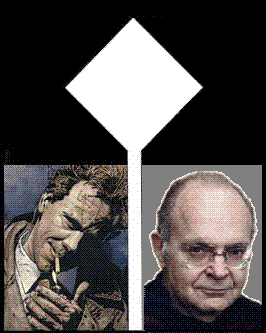
John Constantine,
cartoon character, and
Donald E. Knuth,
Lutheran mathematician
further to Calvin College’s
unparalleled leadership
in the field of
Christian historiography….”
A photo opportunity —

and a recent cartoon:
From Calvin College,
today’s meditation:
Tuesday, June 27, 2006
Tuesday June 27, 2006
Revisited
In memory of
Irving Kaplansky,
who died on
Sunday, June 25, 2006
“Only by the form, the pattern,
Can words or music reach
The stillness, as a Chinese jar still
Moves perpetually in its stillness.”
— T. S. Eliot
Kaplansky received his doctorate in mathematics at Harvard in 1941 as the first Ph.D. student of Saunders Mac Lane.
From the April 25, 2005, Harvard Crimson:
Ex-Math Prof Mac Lane, 95, Dies
Gade University Professor of Mathematics Barry Mazur, a friend of the late Mac Lane, recalled that [a Mac Lane paper of 1945] had at first been rejected from a lower-caliber mathematical journal because the editor thought that it was “more devoid of content” than any other he had read.“Saunders wrote back and said, ‘That’s the point,'” Mazur said. “And in some ways that’s the genius of it. It’s the barest, most Beckett-like vocabulary that incorporates the theory and nothing else.”
He likened it to a sparse grammar of nouns and verbs and a limited vocabulary that is presented “in such a deft way that it will help you understand any language you wish to understand and any language will fit into it.”
A sparse grammar of lines from Charles Sanders Peirce (Harvard College, class of 1859):
Related entry: Binary Geometry.
Friday, June 23, 2006
Friday June 23, 2006
Binary Geometry
There is currently no area of mathematics named “binary geometry.” This is, therefore, a possible name for the geometry of sets with 2n elements (i.e., a sub-topic of Galois geometry and of algebraic geometry over finite fields– part of Weil’s “Rosetta stone” (pdf)).
Examples:
- Charles Sanders Peirce, “The Simplest Mathematics.”
- Donald E. Knuth’s discussion of binary hypercubes in “Boolean Basics,” a draft of section 7.1.1 in The Art of Computer Programming, Volume 4: Combinatorial Algorithms
- My own discussion of a binary hypercube in Geometry of the 4x4x4 Cube
- A more sophisticated example: the geometry of elliptic curves over a binary Galois field. For an excellent introduction, see the Certicom online elliptic curve tutorial. This has an applet illustrating elliptic curves in a space of 256 points (256=16×16, with the x and y variables of a curve each having 16 possible values).
- In summary, apart from the fact that the native language of computers has characteristic 2, “binary” mathematics, i.e. mathematics in characteristic 2, is of special interest both in the study of finite geometry (Finite Geometry of the Square and Cube) and in algebraic geometry (see, for instance, the work of Brian Conrad).
Monday, August 4, 2003
Monday August 4, 2003
Venn's Trinity
Today is the birthday of logician John Venn.
From the St. Andrews History of Mathematics site:
 "Venn considered three discs R, S, and T as typical subsets of a set U. The intersections of these discs and their complements divide U into 8 non-overlapping regions, the unions of which give 256 different Boolean combinations of the original sets R, S, T."
"Venn considered three discs R, S, and T as typical subsets of a set U. The intersections of these discs and their complements divide U into 8 non-overlapping regions, the unions of which give 256 different Boolean combinations of the original sets R, S, T."
Last night's entry, "A Queer Religion," gave a Catholic view of the Trinity. Here are some less interesting but more fruitful thoughts inspired by Venn's diagram of the Trinity (or, indeed, of any three entities):
"To really know a subject you've got to learn a bit of its history…."
— John Baez, August 4, 2002
"We both know what memories can bring;
They bring diamonds and rust."
— Joan Baez, April 1975
For the "diamonds" brought by memories of the 28 combinations described above, consider how the symmetric group S8 is related to the symmetries of the finite projective space PG(3,2). (See Diamond Theory.)
For the "rust," consider the following:
"Lay not up for yourselves treasures upon earth, where moth and rust doth corrupt…."
— Matthew 6:19
The letters R, U, S, T in the Venn diagram above are perhaps relevant here, symbolizing, if you will, the earthly confusion of language, as opposed to the heavenly clarity of mathematics.
As for MOTH, see the article Hometown Zeroes (which brings us yet again to the Viper Room, scene of River Phoenix's death) and the very skillfully designed website MOTHEMATICS.












